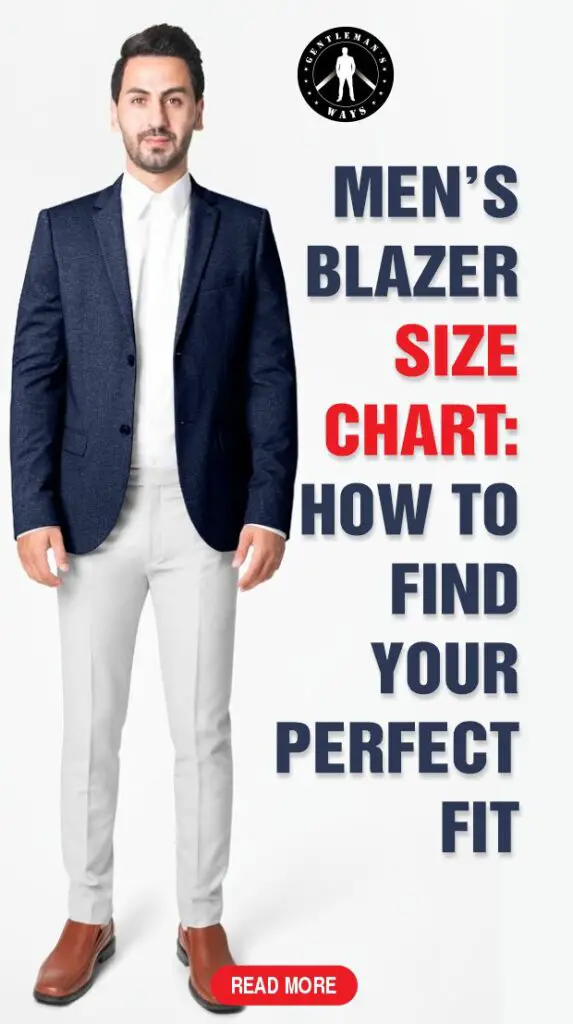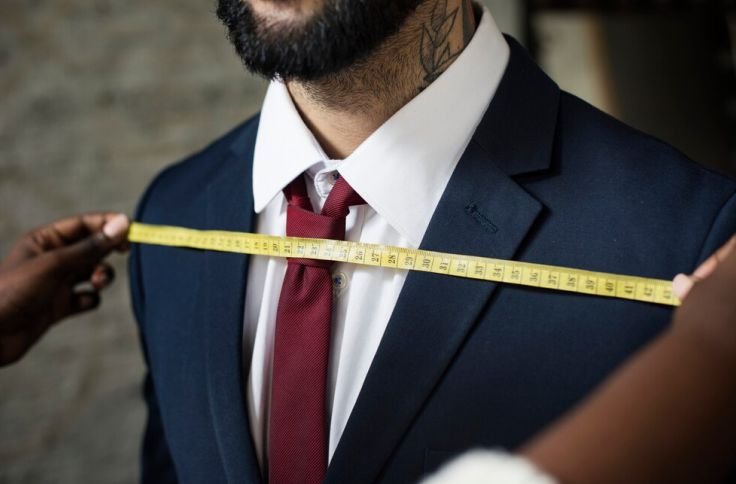Last updated on May 8th, 2025 at 03:52 am
Struggling to find a blazer that fits just right? This men’s blazer size chart takes the guesswork out of sizing so you can look sharp, confident, and perfectly tailored.
You don’t need to guess your blazer size or settle for a poor fit. If you’ve ever tried on a blazer that felt tight in the shoulders or baggy at the waist, you’re not alone.
Men’s blazer sizing can be confusing because sizes vary across brands and regions. One number doesn’t fit all and this can easily cause you to misstep in the men’s fashion etiquette.
That’s why knowing your measurements and understanding what those size labels mean makes all the difference.
A blazer should follow the shape of your body without pulling or sagging. It should move with you, not against you.
In this guide, you’ll find a clear men’s blazer size chart, practical measuring tips, and advice to avoid the most common fit problems.
If you want a smart, confident look every time you put on a blazer, this is where you start.
Recommended: The Basics of Men’s Style and Fashion Guide

Table of Contents
- Understanding Men’s Blazer Sizing
- Men’s Blazer Size Chart (US/UK/EU Conversion)
- How to Measure Yourself for a Blazer
- Fit Types and Styles: What You Need to Know
- Common Sizing Mistakes to Avoid
- Tips for Buying Blazers Online
- Frequently Asked Questions About Blazer Sizing
- Conclusion
Understanding Men’s Blazer Sizing
Buying a blazer shouldn’t feel like a guessing game. Before you click “add to cart” or head to the fitting room, it helps to understand how blazer sizing works.
Blazers, suits, and jackets may look similar, but the sizing can be different.
Blazers usually fit a bit looser than suit jackets, but they still need accurate measurements to look right and feel comfortable.
Recommended: Buying Guide for Casual Blazers for Men
Focus on These Key Measurements
To find your correct blazer size, measure the following:
- Chest size: This is the base of your blazer size. Wrap a soft tape measure around the fullest part of your chest. Keep it level and snug but not tight.
- Sleeve length: Start at the shoulder seam and measure to your wrist. Your sleeves should stop right at your wrist bone, letting your shirt cuff peek out just slightly.
- Shoulder width: Measure from the edge of one shoulder to the other. This affects how the blazer sits and moves with you.
- Blazer length: Your height helps decide if you need a short, regular, or long blazer. Most blazers should fall just below the hip for a balanced look.
What the Size Labels Mean
Blazer sizes are usually written with a number and a letter. For example:
- 38R: The number is your chest measurement in inches
- R: This letter shows the length category, R for regular, S for short, and L for long
Getting familiar with these labels saves you from guessing and returns. Once you know your numbers, shopping becomes easier and quicker.
When a blazer fits well, it doesn’t just sit on your body, it works with it. Use this sizing guide as your tool to shop smarter and wear better.
Related Posts
- Guide on How to Pick a Men’s Blazer
- How to Pair a Men’s Blazer with Jeans
- Guide to Men’s Fashion Accessories
- Complete Guide to Men’s Dress Shoes
- Men’s Chinos: Types, Styling and Accessories
- Blazer Outfit Ideas for Men
- Comprehensive Guide to Men’s Suits
- How to Get Cheap Blazers
Men’s Blazer Size Chart (US/UK/EU Conversion)
If you’ve ever ordered a blazer online and ended up with one that doesn’t fit, you know how sizing can be confusing.
Different countries use different systems, and brands don’t always use the same measurements.
To save you the hassle, here’s a clear men’s blazer size chart that compares chest and waist measurements with standard blazer sizes across the US, UK, and EU.
Use this as a reference before you buy. Always double-check with the brand’s size chart, but this guide gives you a reliable starting point.
| Size (US/UK) | EU Size | Chest (inches) | Chest (cm) | Blazer Fit |
|---|---|---|---|---|
| 34 | 44 | 34 – 35 | 86 – 89 | Extra Slim Fit |
| 36 | 46 | 36 – 37 | 91 – 94 | Slim Fit |
| 38 | 48 | 38 – 39 | 96 – 99 | Slim / Regular Fit |
| 40 | 50 | 40 – 41 | 101 – 104 | Regular Fit |
| 42 | 52 | 42 – 43 | 106 – 109 | Regular / Classic Fit |
| 44 | 54 | 44 – 45 | 111 – 114 | Classic Fit |
| 46 | 56 | 46 – 47 | 116 – 119 | Classic / Loose Fit |
| 48 | 58 | 48 – 49 | 122 – 125 | Loose Fit |
| 50 | 60 | 50 – 51 | 127 – 130 | Oversized Fit |
How to Use This Chart
- Chest size: Measure around the fullest part of your chest. That number matches the size label.
- Waist size: Measure at your natural waistline. This helps ensure the blazer won’t feel too tight or loose at the midsection.
- Sleeve length: Measure from the top of your shoulder down to your wrist. This keeps the cuff at just the right spot.
The sizes listed here are standard, but always compare your measurements with each brand’s chart before buying.
That small step ensures your blazer fits better and feels right from the first wear.
Recommended: Capsule Wardrobe Essentials
How to Measure Yourself for a Blazer
Getting the right blazer size starts with knowing your exact measurements.
You don’t need fancy equipment, just a soft measuring tape, a mirror, and something to write on.
Wear a fitted shirt while measuring so your numbers are accurate. Bulky clothes can throw off the fit.
Measure Your Chest
Start with your chest. This is the number you’ll use most when picking a size. Stand straight and wrap the measuring tape around the widest part of your chest.
Keep it level and snug, but not tight. Breathe normally, don’t puff out or hold your breath. Write down the number in inches.
Measure Your Arm Length
Slightly bend your elbow. Start the tape at the top of your shoulder and run it down to your wrist bone.
This helps make sure the blazer sleeves will stop right where they should, at the wrist, showing a bit of shirt cuff.
Related: Difference between a Blazer and Suit Jacket
Measure Shoulder Width
Ask someone to help if you can. Measure across your upper back from one shoulder edge to the other.
Follow the natural curve of your back. This is key to making sure the blazer doesn’t pull or feel tight across your shoulders.
Measure the Blazer Length
Start at the base of your neck and measure straight down to where you want the blazer to end. Most blazers stop around the middle of your buttocks.
If you’re taller or shorter than average, this part can help you choose between short, regular, or long options.
A Few Extra Tips
- Stand naturally. Don’t suck in your stomach or stiffen your arms.
- Double-check each measurement to be sure.
- If you’re in between sizes, go with the larger one for comfort.
You can also use online tools or size guides from specific brands to match your measurements to their sizing.
Some websites even offer printable measuring tapes or step-by-step videos if you want a little more help.
Related: The Best Men’s Jackets for Fall
Fit Types and Styles: What You Need to Know
Choosing the right blazer fit makes all the difference in how you look and feel. The fit affects your movement, how the blazer sits on your body, and how polished you appear.
Here’s a clear breakdown of the three most common blazer fits and what each one offers:
Slim Fit
If you prefer a closer fit to the body, slim fit is for you. It follows your shape with less room in the chest, shoulders, and sleeves.
The waist is tapered for a clean, sharp line.
Slim fit works best if you have a lean or athletic build. It gives a sharp profile but may feel tight if you have a broader chest or bigger arms.
This style is popular for business meetings, weddings, and date nights.
Classic Fit
Go with classic fit if you want more room and comfort. This cut gives you space in the chest and arms without looking baggy. It’s a timeless option that suits most body shapes.
You’ll find it easy to move in and comfortable for long hours. It pairs well with dress shirts and layers, making it great for work, travel, or everyday wear.
Modern Fit
Modern fit is the middle ground. It gives you a sharp look like slim fit, but adds just enough room to stay comfortable. The chest and shoulders have a bit more ease, while the waist still looks tailored.
If you want a fitted look without giving up comfort, this is a strong choice. It’s popular for office wear and events where you want to look put together but not overly formal.
Related: Blazer Outfit Ideas for Gentlemen
Common Sizing Mistakes to Avoid
Getting the right blazer size starts with accuracy. A few small errors can lead to a poor fit. Here’s what to watch out for when buying a blazer:
Using Your T-Shirt Size as a Guide
A common mistake is picking your blazer size based on what you wear in t-shirts. Blazers are built with structure, so this method does not work. T-shirts are more forgiving. Blazers are not.
What to do instead: use a measuring tape and write down your chest, waist, and hips. These numbers give a better picture of your frame.
Ignoring Shoulder Fit
Shoulder fit matters more than you think. If the blazer hangs past your shoulder or pulls too tight, it will throw off the whole look.
Tip: The seam should line up where your shoulder ends. If it doesn’t, the rest of the blazer will feel off, no matter how well it fits elsewhere.
Getting Sleeve Length Wrong
Your sleeves should end just above your wrist bone. This small detail gives your blazer a clean and finished look. It also lets your shirt cuff show, just a little.
If the sleeves are too long or too short, the blazer won’t look sharp, even if everything else fits.
Not Thinking About Layers
Do you plan to wear a dress shirt, vest, or sweater under your blazer? If yes, take that into account when measuring. Otherwise, the blazer may feel tight once you layer up.
Try this: wear what you normally would under a blazer while measuring your chest and shoulders.
Skipping Tailoring
Even a good blazer might need small changes. Tailoring is not a luxury—it’s part of the process. Shortening sleeves or adjusting the waist can take your fit from okay to spot-on.
Don’t wait: find a local tailor and get it done after you buy. It makes a big difference.
Final Tip
Measure first. Pay attention to fit at the shoulders and sleeves. Think about layers. Don’t skip tailoring.
You’ll save time, money, and avoid wearing a blazer that doesn’t suit you.
Would you like a printable checklist to help you avoid these mistakes when shopping?
Related: Summer Blazer Ideas for Stylish Men
Tips for Buying Blazers Online
Shopping for blazers online can be a time-saver, but it requires some careful steps to get the right fit. Here’s how you can improve your chances of finding the perfect blazer:
Understand the Size Guides
Start by reading the size guide for each brand. Sizes can vary, and what’s considered a medium in one brand might be a large in another.
Measure your chest, waist, and shoulders, and compare those measurements to the retailer’s size chart.
This will help you understand how the brand’s sizing system matches up with your body.
Read Customer Reviews
Customer reviews are a great way to learn about the fit and quality of a blazer. Look for feedback on how the blazer fits different body shapes.
Reviews can also tell you if the sizing is accurate or if there are any issues with the fabric or stitching.
This can save you from buying a blazer that may not live up to your expectations.
Check the Return and Exchange Policy
Before you make your purchase, check the store’s return and exchange policy.
Make sure you understand how long you have to return or exchange the blazer, and if return shipping is covered.
Knowing this information will give you peace of mind in case the blazer doesn’t fit or isn’t what you expected.
Frequently Asked Questions About Blazer Sizing
What size blazer should I wear if I’m in-between sizes?
If you’re between sizes, choose the larger size for comfort, then consider tailoring it to achieve a perfect fit. A professional tailor can adjust key areas for optimal style.
Can blazers be altered to fit better?
Yes, blazers can usually be altered to improve fit. Common adjustments include taking in the waist, shortening sleeves, and narrowing the shoulders. Tailoring ensures a more personalized fit.
What’s the difference between short, regular, and long sizes?
Short sizes are for individuals under 5’8″, regular suits fit average height men, and long sizes suit taller men. These sizes adjust the blazer’s length and sleeve proportion accordingly.
How do I measure my blazer size at home?
To measure at home, use a flexible tape to measure your chest, shoulders, and sleeve length. Compare these measurements with size charts to find the closest match for your body type.
Conclusion
Choosing the right blazer can make a big difference in both your style and comfort.
By understanding sizing, knowing how to take measurements, and comparing them to a men’s blazer size chart, you can make smarter choices that fit your body perfectly.
Fit is key, not just for looks, but for how you feel when wearing the blazer.
Whether you prefer a slim, tailored fit or a more relaxed style, understanding size variations helps you find the right one.
Take your time and be confident in your search. Try on different options in stores or shop online with your measurements ready.
The right blazer will complete your look and boost your confidence.
References
- Fit and Size of Men’s Business Clothing
- Best Practices in Apparel Sizing
- Men’s Clothing Size Charts
- Different Size Measurements for Blazers
Pyo Merez is a men’s lifestyle enthusiast and writer about the gentleman’s place and impact on society. Raised by a distinguished gentleman dad, he offers unique insights into how the mind of a gentleman works and how societal norms shape gentlemen’s identity and vice versa.
Through his insightful articles, Pyo taps into the depths of gentleman culture to provide perspectives on etiquette and manners in modern society.

